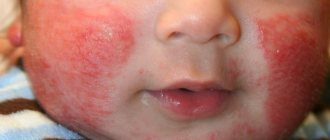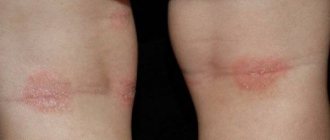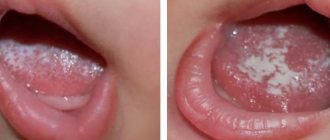Staphylococci are widespread in the surrounding world, many of them constantly live in the human body, without causing any worries. But staphylococcus can also cause quite a lot of problems. Under certain conditions, it is activated and begins to infect the little person’s body. Let's figure out how dangerous staphylococcus is in infants.
Causes
Scientists learned about these microbes many years ago. They were discovered at the end of the 19th century. These microorganisms did not get their name by chance. When viewed through a microscope, they resemble special clusters, which in Greek means “staphylos” . The color of colonies of these microbes is usually yellow or has a faint orange tint.
These microorganisms are quite stable in the external environment. They are able to maintain their vital functions even in the most extreme conditions.
Microbes may not die even when in a hydrogen peroxide solution. This chemical product can cause various rashes on human skin, but does not pose any danger to staphylococci.
Many disinfectants and even certain groups of antibiotics cannot have a detrimental effect on these microorganisms.
This feature is determined by the special cellular structure. On the outside, the microbe is covered with a powerful capsule, which protects it from various environmental influences. It should be noted that even the inability to form spores protects staphylococci from death in unfavorable external conditions.
These microbes have a whole arsenal of a wide variety of toxic substances. Among the most dangerous are special bacterial components called hemolysins. They can have a detrimental effect on many blood cells, including red blood cells and white blood cells. This ability influences the development of unfavorable symptoms in the sick baby in the future.
Bacterial toxins that microbes secrete during their life processes have a pronounced inflammatory effect. They activate the immune response, causing the immune system to release a huge amount of a wide variety of biologically active substances.
For these microorganisms, there is not a single internal organ that they cannot enter. The spread of infection is rapid. Bacteria reach internal organs through the systemic bloodstream.
The prevalence of staphylococcal infections in children is extremely high. The predominant method of infection in newborns and infants is contact. In this case, dangerous microbes enter the child’s skin through dirty hands.
Every year in our country there are outbreaks of purulent pathologies in newly born children who are still in maternity hospitals. In this case, babies become infected through insufficiently well-treated instruments or the hands of medical staff.
Familial cases of the disease also occur. They are mainly caused by violation of personal hygiene rules.
If the towels used daily for hygienic toileting of the baby are not washed and ironed in a timely manner, then they quite often get various mixed infections. Staphylococci survive well on textiles.
Only washing in hot water using detergents, and then ironing with a very hot iron on both sides has a detrimental effect on these microorganisms.
There is also an airborne method of infection. In this case, microbes enter the mucous membranes of the upper respiratory tract of a healthy child from a sick one. A newborn baby can also become infected from a carrier of the disease.
Premature babies, as well as babies with congenital immunodeficiency conditions, are at high risk. Abnormalities in the functioning of internal organs also increase the likelihood of contracting various types of infection.
In infants, symptoms of the disease often appear in the first months after birth. This situation usually occurs with intrauterine infection. Staphylococcus aureus is a fairly small microbe that can penetrate the fetus through the bloodstream of the placenta from an infected mother.
Placental pathologies present during pregnancy increase the risk of contracting a staphylococcal infection several times in the youngest patients.
Provoking factors in babies in the first months of life include severe hypothermia or overheating. These reasons often contribute to decreased immunity.
If for some reason the baby is bottle-fed, the risk of developing infectious diseases increases several times. Babies who receive breast milk are more protected from staphylococcal infections. This is due to the presence of a sufficient amount of protective antibodies, which they receive from the mother during breastfeeding.
It should be noted that not all children can get a staphylococcal infection, even if it enters the child’s body.
Children with strong immunity and no chronic diseases of internal organs can only be carriers. Typically, this form occurs in every third child infected with Staphylococcus aureus. In this case, the disease develops only with a pronounced decrease in immunity.
Causes of staphylococcal infection
Staphylococcus aureus appears in newborns in several cases. Firstly, if the baby becomes infected from a sick mother or a mother carrying the bacteria. In this case, infection can occur in three ways:
- when a woman has contact with a child;
- when feeding through breast milk;
- infection can occur directly during the passage of the child through the mother’s birth canal.
Secondly, Staphylococcus aureus can appear in a newborn if personal hygiene rules are not followed in a medical facility or at home. For example, if the mother does not wash the baby often enough, washes his hands, etc., because the child constantly puts something in his mouth, and staphylococcus is everywhere around us and can easily get on the body and hands.
Also, staphylococcus often appears in newborns due to infection from maternity hospital medical staff. This happens in cases where health workers were not promptly identified with this pathogen or they do not thoroughly clean their hands before performing procedures for caring for the baby in a maternity hospital, which is why staphylococcus from the environment gets onto the newborn.
Staphylococcus aureus can also enter the newborn's body by airborne droplets, but in this case it causes pathologies such as tonsillitis, pharyngitis and rhinitis of staphylococcal etiology. Sometimes newborns become infected with this bacterium through the umbilical wound, again due to insufficient hygiene by the maternity hospital staff or the mother herself.
Staphylococcus is detected in a certain amount in the body of every newborn, but not everyone provokes the development of dangerous pathologies. Most often they develop in children who have reduced immunity. Predisposing factors to the development of the disease may be:
- prematurity;
- pathological course of pregnancy and delivery;
- malnutrition of the newborn.
Also, in children who have gone home, Staphylococcus aureus can develop in cases where they often suffer from acute respiratory viral infections and their immune defense is impaired. Parents may encounter this pathology in a child suffering from dysbacteriosis.
Symptoms
Staphylococcus aureus is a universal microbe in its ability to penetrate various internal organs. Its colonies can be found almost everywhere.
The incubation period for staphylococcal infections varies. Some pathologies develop within 3-6 hours from the moment microbes enter the child’s body. The incubation period for other clinical forms can be 2-5 days.
In premature babies, adverse symptoms can appear quite quickly. This is caused by an insufficiently efficient functioning of the immune system.
The duration of persistence of unfavorable symptoms of the disease also varies and is largely determined by the localization of the inflammatory process. Typically, most staph infections clear up in 7-14 days.
The skin becomes a fairly common location for these microbes. When they get on the skin, they cause a wide variety of manifestations. They are manifested by the appearance on the skin of multiple furunculous formations, pimples, red spots, ulcers, purulent-necrotic changes
The peculiarity of such skin rashes, as a rule, is the presence of pus inside the cavity. Its amount may vary and depends on the severity of the disease.
Purulent manifestations on the skin can be localized or widespread. Newborn babies have a rather unfavorable tendency for the spread of purulent rashes. This is due to the looseness of subcutaneous fat and good blood supply to the skin. After just a few days, the local process becomes generalized.
Pustules can appear on a variety of areas of the skin. Staphylococcus aureus loves to live in the sweat and sebaceous glands. This determines the fact that with the development of staphylococcal infection, symptoms of furunculosis or hidradenitis often appear. In this case, purulent formations appear in the area of hair follicle growth. They look like pustules, round or elongated, containing yellow or greenish pus inside.
The course of purulent formations is quite unfavorable. If diagnosis is not carried out in a timely manner and there is no treatment, this contributes to the development of many dangerous complications in the sick child. In this case, a mandatory consultation with a pediatric or purulent surgeon is required.
Purulent rashes on the skin may burst, causing pus to leak out. In this case, usually ulcers remain in place of the former pustules, which heal over time, forming small scars.
Staphylococcus aureus is a fairly common uninvited “guest” on the mucous membranes of the upper respiratory tract. It gets there mainly by airborne droplets. Quite often this happens during a normal conversation with a patient or carrier of the infection.
If parents have Staphylococcus aureus in the nasal cavity, then they can quite easily infect their newborn baby with it.
When staphylococci get on the mucous membranes of the upper respiratory tract, they cause various unfavorable symptoms in the child. The most common of them is persistent rhinitis, manifested by a severe runny nose.
Nasal discharge is usually thick, profuse, and has a yellow or greenish tint. Without treatment, staphylococcal rhinitis leads to the development of inflammatory diseases of the paranasal sinuses, which manifest themselves in the baby as sinusitis or sinusitis.
Staphylococcal infection quickly spreads to nearby organs. The presence of bacteria in the nasopharynx leads to the development of inflammation in the pharynx and throat. This contributes to the formation of bacterial pharyngitis in the baby, and then tracheitis. These pathologies are quite severe in newborn babies. They are accompanied by the appearance of cough, severe intoxication syndrome, and severe pain when swallowing.
The danger of these conditions is that they can lead to the development of dangerous complications - bacterial bronchitis or pneumonia.
Lesions of the gastrointestinal organs are also very common with this infectious pathology. Staphylococcus aureus enters this anatomical zone through the systemic bloodstream.
Gastrointestinal forms of staphylococcal infections , according to statistics, have the shortest incubation period.
Infection can also occur as a result of consuming fermented milk products or ready-made purees from jars that babies eat as first complementary foods.
Once in the intestines, pathogenic microorganisms lead to a pronounced disruption of the normal biocenosis of the intestinal flora. This contributes to the development of severe dysbiosis in the child.
This pathological condition manifests itself in children, as a rule, with various stool disorders. A sick child may develop diarrhea or persistent constipation. In some cases there may be alternation between them.
Staphylococcal infection in the gastrointestinal tract is also quite often manifested by the appearance of abdominal pain in a sick baby.
Babies in the first months of life cannot yet tell their parents their complaints about what hurts. You can suspect pain in the baby’s tummy only by observing his behavior. If after eating a child begins to cry or asks to be held more often, then this symptom should seriously alert parents. In some cases, a sick baby tries to limit his active movements, as this increases the pain.
Any staphylococcal infection, regardless of the initial location, leads to a marked deterioration in the baby’s well-being.
The child becomes paler and lethargic. Sick children have a noticeable decrease in appetite. This usually manifests itself in the fact that infants begin to refuse breastfeeding.
With this bacterial infection, body temperature rapidly increases. The severity of this increase may vary and depends largely on the severity of the infection.
Typically, staphylococcal infection in newborns leads to an increase in temperature to 38-39.5 degrees. High numbers can persist in the baby for several days, and without treatment, much longer.
The situation is aggravated by the presence of a pronounced intoxication syndrome. It is usually manifested by the appearance of severe dryness of the baby’s skin and visible mucous membranes, an increase in severe thirst, a decrease in skin turgor, as well as changes in behavior. The kids begin to be capricious and have trouble falling asleep. During sleep they can wake up many times and even cry.
Symptoms of staphylococcus in infants
Staphylococcus infection manifests itself quite quickly. Staphylococcus aureus is an extremely aggressive and virulent pathogenic microorganism that detects its presence almost immediately after infection. The normal level of Staphylococcus aureus in the body is zero. If the infection occurred in a maternity hospital, then by 2-5 days the baby begins to have problems with the gastrointestinal tract.
The main symptom is frequent bowel movements. However, even in a healthy baby fed with breast milk, bowel movements can be regular and quite frequent.
In this case, the disease can be identified based on additional symptoms:
- Skin rashes (pustules, boils, etc.);
- Long-term non-healing navel;
- Gushing regurgitation;
- The appearance of green, pus, blood in the stool;
- Changes in the color and structure of stool: yellow or greenish stool, foamy.
Children older than one month suffer from staphylococcal infections somewhat less frequently, and their symptoms differ. In such children, the disease occurs as gastroenterocolitis or toxic infection.
Toxic-infectious type damage
Staphylococcus often forms colonies on the surface of food. During its life, the microorganism actively produces enterotoxins. After eating contaminated foods, both the bacteria themselves and the toxins they produce enter the child’s body.
Symptoms include:
- Signs of general intoxication of the body (increase in body temperature to 37.5-39.0, headache, weakness and lethargy, drowsiness, nausea);
- Paleness of the skin;
- Frequent vomiting and diarrhea.
Most often, a child’s body is attacked by bacteria when consuming the following products:
- Fermented milk products: milk, cottage cheese, kefir, etc.;
- Fruit and vegetable juices;
- Baby food from jars.
Parents who constantly feed their children store-bought food are especially at risk. As you know, such products are often transported and stored incorrectly.
Any doctor from a children's infectious diseases hospital can talk about many patients under two years of age who were fed expired Agusha, Frutonyanya or Rastishka and ended up in the hospital with severe poisoning.
Children infected with staphylococcus suffer from the disease much more severely than adults:
- A high degree of intoxication leads to the fact that the child practically refuses to eat;
- Frequent diarrhea and vomiting lead to dehydration and removal of electrolyte salts from the body. As a result, metabolism is significantly disrupted;
- If a child experiences frequent manifestations of toxic infection, and they are severe (pallor after vomiting, problems with sleep and awakening), you should immediately transport the child to the hospital on your own or by calling an ambulance.
Gastroenterocolitis-type lesion
The acidity of a child's stomach does not have the same degree as that observed in an adult. During its life, staphylococcus produces a lot of enzymes and toxins that destroy the cellular structures of the mucous membranes. As a result, damage occurs to the mucous membrane of the stomach, small and large intestines. The so-called gastroenterocolitis develops.
The disease includes two components:
- Gastritis. In children, the disease is expressed in refusal to eat and frequent vomiting. It is not so easy to distinguish vomiting from natural regurgitation without special knowledge. To draw the right conclusion, you need to keep in mind that experts consider vomiting in an infant to be a volume of vomit that exceeds three tablespoons. Regurgitation more than three times a day is also considered pathological.
- Gastritis in children is accompanied by symptoms of intoxication, as well as respiratory disorders (breathing is hoarse or noisier);
- The child's voice becomes hoarse;
- The sucking reflex weakens;
- Dry lips are observed. The eyeballs visually sink deeper;
- The peritoneal wall loses its tone. As a result of a functional test (pinching the skin), the fold straightens out slowly. This indicates dehydration of the body.
- Enterocolitis. It is a lesion of the mucous membrane of the large and small intestines. For diagnostic purposes, a stool test is performed. Normally, staphylococcus should not be detected in feces, but a small amount is considered normal, since even children's immunity can suppress the infection. To make a diagnosis of infectious enterocolitis, the level of staphylococci in the feces must be 10 to the power of 2 colony-forming units per gram.
It is impossible to cope with the disease at home; you should immediately transport the child to a hospital and begin specific therapy.
The clinical picture is typical for severe colitis:
- Frequent diarrhea mixed with mucus, pus, and blood;
- Light yellow feces, upon contact with atmospheric air, take on a green tint;
- Milk is not completely processed in the body. Lumps of curdled milk are found in the stool;
- After several bowel movements, feces lose their structure and take on the appearance of yellowish or green water;
- Wandering abdominal pain;
- The child becomes restless. The picture is similar to intestinal colic (pulls legs towards stomach, screams, etc.);
- Bloating and increased production of intestinal gases (rumbling in the abdomen), frequent passing of gases;
- Signs of dehydration gradually develop: dry skin, loss of skin elasticity, sunken eyeballs, etc.
Pathology can be determined quite simply by the number of bowel movements per day. If a breastfed baby has bowel movements 7-10 times, this is not the norm. In bottle-fed children, the normal number of bowel movements is 1-2 times a day.
The presence of foreign impurities (blood, mucus, pus) in the structure of feces always indicates a pathological process in the area of the large or small intestines.
If the number of staphylococci in the stool is less than a certain norm, a diagnosis of dysbacteriosis is made. It often happens that pediatricians talk about dysbiosis even when the specified value is exceeded. However, in this case we are talking about infectious enterocolitis. Accordingly, the treatment should be different.
Symptoms of Klebsiella in infants
Klebsiella is an opportunistic microorganism because it is constantly present in the human body. These bacteria hold the record for the frequency of intestinal infections they cause. Most often, Klebsiella affects the intestines, that is, it belongs to enterobacteria. However, once it penetrates the nasal mucosa, it can cause ozena (fetid runny nose).
Most often, Klebsiella enters the child’s body in a hospital setting.
There are several causes of infection:
- Adults often neglect the rules of personal hygiene and sanitation of household items. Klebsiella usually enters a child’s body after contact with the hands of an adult carrier or dirty objects;
- Klebsiella often infects infants during interaction with public toys in clinics and hospitals;
- Contact with a dirty pacifier. If a pacifier falls on the changing table or floor, parents will often wipe (and sometimes suck on) the object and place it back in the baby's mouth. This is a direct path to infection.
Klebsiella is generally characterized by the same symptomatic complex. However, unlike Staphylococcus aureus, the bacterium is less aggressive and primarily affects children with weakened immunity, dysbacteriosis, or an existing staphylococcal infection.
The main clinical difference between Klebsiella and staphylococcus is the color of the stool. If with a staphylococcal infection the stool is light yellow, then with a Klebsiella infection it is dark green. Klebsiella is also characterized by more active gas formation.
Diagnostics
When the first adverse symptoms appear, you should immediately show your child to a doctor. If your baby has a high temperature, you should not go to the clinic on your own. In this case, it is better to call a doctor at home.
The doctor will examine the baby and be able to make a preliminary diagnosis. During a clinical examination, the doctor will not be able to say exactly what caused this disease. This requires a whole range of different diagnostic methods to accurately identify infectious agents. These laboratory tests allow doctors to distinguish normal from abnormal.
All children with signs of a bacterial infection must undergo general clinical tests. In the blood, leukocytes and ESR increase, and normal indicators in the leukocyte formula change.
In some cases, Staphylococcus aureus can also be found in the urine. This is possible mainly with urinary tract infections. To establish a diagnosis in this case, bacterial culture of urine on special nutrient media is required.
Quite often, a stool test is performed to identify infectious agents. This simple and absolutely painless examination for the child allows us to identify various microbes that become sources of infectious pathologies of the gastrointestinal tract in sick children.
The presence of pathogenic bacteria in the stool may indicate carriage or infection with this infection.
The presence of Staphylococcus aureus may be present in tests, but not accompanied by the appearance of adverse symptoms.
Thus, a microbial titer of 10 to 3 degrees usually does not manifest itself in any visible clinical signs. It only indicates that when exposed to factors leading to a decrease in immunity, the baby may develop this infectious pathology.
The content of microbes in the feces of 10 to 4 degrees is accompanied by the appearance of symptoms that are slightly expressed. Such test results are found in children who have local and limited skin purulent rashes or a mild course of infectious staphylococcal infection of internal organs.
Usually, doctors do not prescribe specific treatment, but only get by with general tonic and mild immunostimulating medications. In some cases, Staphylococcus aureus appears in the stool along with Klebsiella.
The content of microorganisms 10 to 5 degrees is already accompanied by the development of unfavorable symptoms in the child. The degree of their severity may vary. Quite often in this case, diarrhea occurs with the release of foamy, foul-smelling feces.
The discharge usually has a greenish tint. The child, as a rule, feels extremely unwell. His weakness increases and his appetite decreases. In this case, pediatricians already prescribe specific antibacterial treatment.
In some cases, instrumental studies are required. They are prescribed to clarify the degree of functional disorders that have arisen, and also help to promptly identify complications that have developed during the course of the disease.
As a rule, such studies include radiography of the lungs and chest, as well as ultrasound examination of the abdominal organs and kidneys.
How to properly test feces for staphylococcus in infants
Collecting tests from children under one year of age often presents certain difficulties. This is especially true for babies with irregular bowel movements, because catching the moment when a bowel movement occurs is often extremely difficult.
Difficulties also arise due to the regular use of diapers, as well as the lack of normal information about how to test for staphylococcus in newborn children.
Bacteriological analysis of stool is quite sensitive to various microorganisms, so you should exclude from the diet everything that can change the real picture of the culture.
You cannot introduce new complementary foods and milk formulas before taking the tests (at least 3-4 days in advance). You should consult your doctor about the risks of receiving false information when taking medications (antibacterial, antihistamine, bacteriophages, etc.).
To collect material from a baby you will need:
- sterile lint-free or oilcloth diaper;
- container for feces with a special spatula.
Experts have ambivalent views on the use of a gas outlet tube to speed up the act of defecation.
Some believe that it will not cause significant harm, while others regard this popular means of relieving gas and speeding up bowel movements as a possibility of changing the results of a bowel test.
An alternative help can be massage of the baby's tummy, carried out in a circle clockwise with a warm and soft hand, as well as bending the baby's legs at the knees and pulling them towards the stomach.
ADVICE! It is advisable that defecation occurs on a sterile diaper, with which a special spatula is used to collect the feces into a sterile container that is tightly closed with a lid. The amount of material should be about 10 g.
Newborns should be tested for staphylococcus in stool only in the morning and brought to the laboratory no later than 40-60 minutes after defecation. Tests received in the laboratory after more than three hours may be unreliable.
Important! If stool collects in the diaper, you should ensure that urine and diaper fibers do not get into it. Contact with feces with water, powders and creams, etc. should be avoided.
Complications
Staphylococcus can be very dangerous. The peculiarity of the course of this infection is that it can quite easily lead to the development of multiple complications. They significantly worsen the child’s overall well-being and can cause long-term adverse consequences in later life.
A fairly common complication is the formation of purulent abscesses in the internal organs.
The predominant localization is lung tissue. Late diagnosis of pneumonia and late treatment help limit the inflammatory process and lead to the development of a local abscess.
This pathology is quite severe in children. Treatment of this pathological condition is carried out only in the pediatric surgical department of the hospital.
Bacterial meningitis is also a rather dangerous complication. The high-risk group includes babies born much earlier than the due date or children who have various abnormalities of the nervous system after birth.
Staphylococcal meningitis is a very serious disease, accompanied by the development of multiple adverse symptoms. These include: an increase in body temperature up to 40 degrees, the appearance of severe headaches, and the possible appearance of epileptic seizures and convulsions.
Treatment of this condition requires the mandatory prescription of a massive course of antibiotic therapy and the introduction of special physiological and colloidal solutions that have an anti-inflammatory and restorative effect.
Risk groups for intestinal pathology
Intestinal disease caused by opportunistic flora can occur in any baby. But there are children who are at increased risk for developing a bacterial infection.
Predisposing factors to the development of infection are the following conditions:
- prematurity;
- malnutrition and intrauterine growth retardation;
- childbirth by cesarean section;
- infected maternal birth canal;
- insufficient child care;
- artificial feeding;
- feeding with infected milk (cracks and mastitis in the mother);
- hospital stay (especially long stay in the postpartum ward);
- untimely and poor-quality complementary feeding;
- a large number of caregivers for the child.
Staphylococcus aureus is the main cause of nosocomial infections. The danger of the flora of medical institutions is that microbes become highly resistant to antibiotics and disinfectants.
Treatment
Therapy for various forms of staphylococcal infections is complex. This may include prescribing various medications. In most cases, treatment of children with signs of staphylococcal infection is carried out in a hospital setting. Delayed hospitalization or refusal of it can lead to a significant deterioration in the baby’s well-being.
Local local forms that occur on the skin can be easily treated using simple aniline dyes that are familiar to many parents. Surprisingly, these aggressive microbes are very sensitive to the effects of ordinary brilliant green.
Treatment of affected pustules with a solution of brilliant green, iodine or furatsilin has a positive therapeutic effect. In some cases, doctors prescribe Vishnevsky ointment, which must be applied to purulent areas of the skin.
The main goal of treatment is to eliminate pathogenic microbes from the newborn baby’s body.
This can only be done by prescribing a course of antibacterial drugs.
This treatment is carried out in a hospital, since antibiotics can be administered there mainly parenterally. This administration makes it possible to somewhat reduce the toxic effect of these drugs on the mucous membrane of the stomach and intestines.
The choice of antibiotic remains with the attending physician. Staphylococci have a fairly high sensitivity to various groups of penicillins and cephalosporins of the latest generations. The course of treatment may vary: from 5 to 10-14 days.
Antibacterial agents from the reserve group, as a rule, are not used. This use contributes to the development of high antibiotic resistance.
The treatment complex necessarily includes anti-inflammatory drugs. They help eliminate inflammation and lead to an improvement in the baby’s well-being. If there is a significant increase in body temperature above 38 degrees, antipyretics are used. They help reduce fever within the first few days after their administration.
To improve the functioning of the immune system, sick children are prescribed immunostimulating drugs.
General restorative therapy also plays an important role in the treatment of infection caused by Staphylococcus aureus in newborns.
In stationary conditions, various physiological solutions are introduced for this purpose, which help improve microcirculation and blood supply in all internal organs. These drugs also have a pronounced anti-inflammatory effect.
With a milder course of the disease, doctors can resort to treating the infection with specific bacteriophages. The need for such therapy is determined only by the attending physician and depends on many different factors.
The decision to choose bacteriophages or antibiotics must be made taking into account the localization of the inflammatory process in the child, as well as the severity of the disease.
Symptoms and signs of staphylococcus disease
Staphylococcus disease in a newborn child can manifest itself in completely different ways. Symptoms will depend entirely on the location of the infection and on which species has begun its active activity. The disease that was caused by the staphylococcus infection will also affect the symptoms. It is worth noting that the external signs of the disease are very easy to confuse with some other disease, and therefore you need to be as careful as possible and in case of any deviations from the norm, you need to consult a doctor as quickly as possible.
- If staphylococcus is on the skin, it can cause a variety of rashes or even suppuration, carbuncles and boils.
- If staphylococcus is on the mucous membrane of the nose or throat, then the child develops a runny nose, cough, and breathing begins to become more frequent several times - all symptoms will resemble the most common cold.
- If staphylococcus affects the mucous membrane of the eye, conjunctivitis may begin to develop, and severe redness may also occur, and pus may form.
- If staphylococcus enters the intestines, it causes a variety of disorders of the digestive system, while the child’s stool changes its character: mucus and watery inclusions appear; The child begins to be capricious due to severe tummy pain.
It is possible to understand that a child is developing a disease caused by staphylococcus only through laboratory testing, and therefore you should consult a doctor at the slightest suspicion.
Prevention
Compliance with the rules of personal hygiene is a very important component of preventive care.
To reduce the risk of contact-household infection, be sure to use your baby’s own towels. These textiles need to be washed and ironed.
Even accidental use of baby towels can lead to infection of the baby.
You should also avoid any contact with feverish or feverish family members. If one of the parents is sick, then he should wear a gauze bandage or mask, which should be changed every 3-4 hours.
During illness, you should limit all possible contacts with your newborn baby. If nursing mothers have pustules in the nipple area, doctors recommend stopping breastfeeding and switching the baby to feeding with artificial, adapted formulas.
You can also read another article about what Dr. Komarovsky thinks about Staphylococcus aureus.
To learn how staphylococcus manifests itself in children, see the next program from Dr. Komarovsky’s school.
After birth, a child encounters many bacteria and microorganisms. Some of them are useful, others are harmless, and some are quite dangerous for the baby’s health. One of these dangerous bacteria is Staphylococcus aureus.
How dangerous is staphylococcus in infants?
In the absence of adequate antibacterial therapy, staphylococcal infection leads to many severe and deadly complications:
- Development of dehydration. Prolonged and painful diarrhea, as well as frequent vomiting, lead to the fact that water along with electrolyte salts is removed from the body at tremendous speed. The body is not able to bring all systems into a state of dynamic equilibrium (homeostasis). As a result, shock may develop and death may occur. In children, dehydration begins much earlier due to less fluid in the body;
- Infectious-toxic shock. Staphylococcus aureus is one of the leaders in reproduction speed. As mentioned, the bacterium produces many toxic substances. With excessive proliferation of toxins and enzymes there are so many that the body loses the ability to maintain all necessary vital functions: the kidneys, heart, liver and brain fail;
- Intestinal bleeding. Long-term enterocolitis leads to destruction of the intestinal epithelium, perforation of its walls and massive bleeding;
- Peritonitis. With perforation of the walls, food and feces leave the intestine, infecting the abdominal cavity;
- Sepsis. By destroying the intestinal walls, staphylococcus can penetrate the bloodstream. This will lead to blood poisoning, and the risk of death will increase many times;
- Development of carriage of Staphylococcus aureus. Even if treatment is carried out timely and effectively, there is a risk of developing carriage of the bacterium. The microorganism begins to exist in a latent form. Clinically, carriage resembles a sluggish dysbacteriosis: decreased appetite, stool instability, diarrhea alternating with constipation and periods of normal bowel function, heaviness in the abdomen, bloating, flatulence (colic), frequent regurgitation.
Over time, either staphylococcus is reactivated, or the child’s immune system, together with bifidumbacteria, will “pacify” the pathogen.
What is Staphylococcus aureus?
Staphylococcus aureus (Staphylococcus aureus) is one of the varieties of bacteria from the staphylococcal family that can cause various diseases.
Staphylococcus aureus is the most harmful and resistant bacterium of all staphylococci.
Almost all diseases associated with staphylococcal infection are caused by this bacterium, or rather by the toxic enzyme that it produces.
It is called golden because when observed under a microscope, it is clear that the colonies of these bacteria are yellow in color. This bacterium is very common. It is found in the body and on the skin of almost every person.
So it’s quite possible to find Staphylococcus aureus in a baby’s stool. There are standards for acceptable levels of the presence of bacteria in the intestines. If this norm is not exceeded, then there is no reason to worry.
epidermal staphylococcus is very common , unlike the first, it is part of the normal microflora of the skin and poses a danger only to weakened and exhausted people, in some cases during pregnancy.
Species and habitat
There are many types of staphylococcus. Of these, there are three types that have the most detrimental effect on the baby’s body:
- Staphylococcus hemolytic. It is the causative agent of sore throat and other respiratory diseases.
- Staphylococcus saprophytic. Can lead to diseases such as urethritis and acute cystitis (rarely found in infants).
- Staphylococcus aureus.
Staphylococcus aureus is considered the most dangerous in infants. Its bacterium can multiply in any organs and infect them, causing purulent diseases. This is a very hardy microorganism: able to withstand high temperatures and even hydrogen peroxide. Staphylococcus aureus in children can cause a huge number of diseases: from purulent pimple, conjunctivitis, lymphadenitis, laryngitis to meningitis, pneumonia, kidney disease, etc.
Bacteria can be located:
- on the skin of a baby;
- in the mucous environment (nose, mouth, throat);
- in the intestines.
Causes of the disease
Staphylococcal infection in an infant can cause inflammatory diseases of the skin (pimples, boils), purulent-inflammatory diseases of the respiratory tract and other inflammatory diseases.
The bacterium itself is not dangerous. Usually the general and local immunity of a healthy person copes with it quite effectively.
But the smaller the baby, the weaker his body and lower his immunity.
The newborn's life support systems do not function fully, and the beneficial intestinal microflora has not been established. Therefore, the risk of developing streptococcal infection in an infant is quite high.
Thus, the causes of the development of the disease can be :
- Failure to comply with sanitary and hygienic standards in the maternity hospital and illness of its employees;
- Violation of personal hygiene by the baby's mother;
- Contact of the baby with relatives and friends sick with staphylococcal infection;
- Decreased infant immunity;
- Failure to follow the rules for caring for a newborn.
Infection of a newborn with the so-called nosocomial staphylococcal infection is especially dangerous. This bacterial infection is very resistant to any influence and is difficult to treat.
There are no bacteria or microorganisms in the newborn’s body immediately after birth. It is practically sterile and therefore the spread of infection does not cause any obstacles and can be quite rapid. This threatens serious complications for the baby's health.
How is it transmitted?
Staphylococcus is transmitted through close contact with a carrier of the infection , through common objects, failure to comply with hygiene standards, and through consumption of contaminated food.
Sometimes a baby becomes infected with the mother's milk if she herself is sick or if the bacteria comes from the skin during feeding.
Once staphylococcus gets on the skin, it can enter the bloodstream through wounds. In the presence of favorable conditions, a staphylococcal infection develops, which causes inflammatory diseases of internal organs.
By airborne droplets, the bacterium is able to penetrate the respiratory system.
What diseases does it cause?
Staphylococcus is considered an opportunistic microbe. This means that it is dangerous only under certain conditions. Most often this is a decrease in immunity.
Infants have not yet fully formed immune systems (local and general), so they get sick more often.
Staphylococcal infections can cause the following diseases:
- Purulent-inflammatory skin diseases;
- Staphylococcal sepsis;
- Purulent sore throats;
- Inflammatory intestinal diseases – gastroenterocolitis;
- Purulent pneumonia;
- Toxic damage to organs and systems;
- CNS lesions, meningitis;
- Other.
Main symptoms
Symptoms of diseases due to streptococcal infection depend on the location of the disease, the degree of its intensity, and the child’s immunity.
The most common symptoms that appear are::
- Skin rash with pustules and inflammation;
- The child’s high temperature does not go down well and rises again;
- Weakness, lethargy;
- Poor sleep and appetite;
- Diarrhea;
- Nausea or vomiting;
- Purulent wounds due to skin disease;
- A characteristic purulent plaque on the tonsils with tonsillitis;
- Dry hoarse cough with laryngitis;
- Difficulty breathing due to pneumonia.
If you suspect an infection, you should immediately consult a doctor. He will examine the baby and refer him for the necessary examination or hospitalization.
The meaning of analysis and its types
Staphylococcus is a type of coccal (spherical) bacteria that resembles grapes in the plural. The main types of this bacterium:
- Staphylococcus aureus, which can cause extensive inflammatory processes in almost all organs of the baby.
- Hemolytic staphylococcus, the development of which leads to purulent-inflammatory processes on the skin and in the genitourinary system.
- Saprophytic staphylococcus, affecting the functioning of the urinary system.
- Epidermal, affecting the skin and mucous membranes.
Newborns and infants (up to one year) are most susceptible to infection with staphylococcus, which often lives within hospital walls, as well as in domestic conditions.
It is resistant to changes in temperature, drying out and the use of antiseptics, making it difficult to control.
Entering and developing in the body of a newborn, coccal colonies negatively affect the functioning of the intestines, causing frequent loose and foul-smelling stools interspersed with greens and blood, regular pain, skin rashes in the form of ulcers, and sometimes problems with urination.
If such signs are present, you should consult a pediatrician to prescribe a scatological examination of stool.
This preliminary analysis will help to identify the presence of an inflammatory process without identifying pathogenic microflora.
If the number of leukocytes or blood content in the stool is increased, the doctor may prescribe a set of tests for the baby:
- fecal analysis for staphylococcus in infants (bacteriological culture aimed at identifying the causative agent of the inflammatory process);
- general analysis and blood culture analysis in case the inflammatory process negatively affects other body systems;
- if damage to the urinary system is suspected, a general urine test and urine culture.
Most often, a pediatrician or infectious disease specialist recommends a bacteriological culture of stool (tank analysis or stool test for dysbacteriosis).
It will show the presence or absence of an increased content of pathogenic flora in the intestines and specify the type of staphylococcus to prescribe effective treatment.
Diagnostic methods
To diagnose the disease, blood, urine, and stool tests are performed . A swab of the throat is taken if necessary. If streptococcal pneumonia is suspected, a sputum test is performed. Based on the test results, a conclusion is made about the presence of inflammation in a certain organ.
Bacterial analysis of collected biological fluids identifies the causative agent of the disease.
If a harmful microorganism is found and it is necessary to prescribe antibacterial therapy, then an analysis is carried out to determine the sensitivity of the bacteria to certain groups of antibiotics.
Why is he dangerous?
Staphylococcus aureus is the most dangerous of all staphylococci.
The bacterium produces a very dangerous toxin .
In severe forms of the disease, the following complications are possible:
- Sepsis (blood poisoning);
- Toxic shock;
- Toxic brain damage;
- Exacerbation and complication of other chronic and congenital diseases;
- Lethal outcome in acute intensive course of the disease.
Therefore, it is important to diagnose the disease in a timely manner and undergo the necessary treatment.
When planning and especially during pregnancy, a woman must be tested for sexually transmitted infections.
Analysis for Ureaplasma Parvum is also included in the list of mandatory ones. Read more about the dangers of this infection during pregnancy by following our link.
Treatment options
Treatment of streptococcal infection is very difficult. This bacterium is resistant to most antibiotics and antiseptics .
It does not die when dried in the sun, in ethyl alcohol, in hydrogen peroxide, and can withstand temperatures of 150 degrees Celsius for 10 minutes, etc.
A tincture or oil solution of chlorophyllipt can successfully treat streptococcal infections in the throat and nasopharynx.
If Staphylococcus aureus is found in the feces of a baby, then treatment is most often not carried out . Treatment is prescribed if there are other symptoms of a possible disease.
Antibacterial therapy for streptococcal infections is selected in cases of development of inflammatory diseases.
First, a test is carried out to determine the sensitivity of the detected bacteria to various types of antibiotics, since many of them cannot cope with bacteria of this type.
In combination, they are also used in the treatment of infection.:
- Preparations to improve intestinal microflora;
- Vitamin complexes;
- Immunomodulatory agents;
- Traditional methods include decoctions of calendula, chamomile and other medicinal plants.
Even after suffering from a disease caused by a staphylococcal infection, the body cannot develop immunity to staphylococcal bacteria. The likelihood of re-infection with this infection is quite high.
Treatment of staphylococcus in infants
Therapy for staphylococcus infections comes down to three main aspects:
- Establishing control over the intensity of microorganism reproduction, destroying pathogens using the method of sanitation and taking bacteriophages;
- Maintenance treatment (restoration of water balance in the body, prescription of therapeutic nutrition);
- Treating infants with antibiotics is absolutely unacceptable. Antibacterial therapy using macrolides or cephalosporins is advisable only in children with confirmed sepsis.
In all other cases, antibiotics destroy the intestinal microflora, and staphylococcus safely continues to exist and enterocolitis flares up even more strongly, since the pathogenic flora no longer experiences competition from bifidum and lactobacilli.
Probiotics do not help in this case, since while taking antibiotics, the beneficial flora does not take root, and staphylococci or Klebsiella quickly destroy the incoming insignificant number of beneficial bacteria.
It is most reasonable to carry out treatment with specialized bacteriophages - viruses that devour a specific type of bacteria:
- Staphylococcus bacteriophage is used in pure form or as a complex (a mixture of phages of Staphylococcus, Salmonella, Shigella, etc.);
- The duration of taking the bacteriophage is 1-2 weeks;
- If there is no therapeutic effect, a second course of treatment is carried out;
- The drug requires special storage conditions. Temperature - no higher than 6 °C. This means that it can only be stored in the refrigerator. For direct use, the drug should be brought to room temperature. It cannot be heated. This is the main difficulty of use.
The following medications are used to fight bacteria:
- Nitrofurans. Stopdiar, Ersefuril, Enterofuril. Their use is allowed starting from one month from birth. The drugs are effective against both staphylococci and Klebsiella. Duration of treatment: 7 days. Children over one year old are recommended to take furazolidone;
- Enterosorbents. Should be used with great caution, as there is a high risk of developing intussusception. It is recommended to take Smecta;
- Immunostimulants. Kipferon is recommended for use in infants. The course of treatment is 5 days;
- Probiotics. Used to restore normal intestinal microflora. Specific names should be selected based on the general health of the child;
- To restore the water-salt balance, complex therapy is used. It is almost impossible to restore balance on your own. Between feedings, the baby should be given clean water at the rate of 100 ml of water per kilogram of weight. After the general condition improves, they move on to maintenance supplementation. The volume of water is 100 ml per kilogram of weight per day. This means that a child weighing 4 kg should receive 400 ml of water per day.
To stop vomiting, cerucal is injected intramuscularly. In combination with it, they continue to take fluids. Every 4-10 minutes - a teaspoon of water. Solutions of hydralazine and rehydron are administered, as well as 5% glucose in a ratio of 1:4. If this method of restoring the water-salt balance is ineffective and symptoms of dehydration are observed, the only way is hospitalization and intravenous infusions.
Prevention
Due to the fact that Staphylococcus aureus is very tenacious, it is extremely difficult to get rid of it.
To prevent staphylococcal infection, it is useful to harden the baby, increasing his immunity, and, consequently, the body’s resistance to various kinds of diseases.
Feed only fresh foods. Follow proper nutrition standards.
You should also follow these recommendations:
- Ventilate the room, walk in the fresh air, wash surfaces with soap and water;
- Limiting the baby’s contact with people who may be carriers of the infection.
You should not unnecessarily visit public places where there is a possibility of infecting a child.
- Thoroughly wash and treat the baby's household items.
Bottles, pacifiers, pacifiers, teethers, rattles and others.
Be sure to choose ones that will be easy to rinse and boil.
Does your child's barking cough go away without fever? This is a reason to urgently consult a doctor!
We are often asked what is hydrocele in an infant. This is a serious diagnosis, which, fortunately, is not confirmed very often.
Mother's milk contains not only useful substances, but also substances that protect the baby from many diseases.
Therefore, breastfeeding, subject to all sanitary standards, is a good measure for the prevention of many diseases, including staphylococcal infections.











